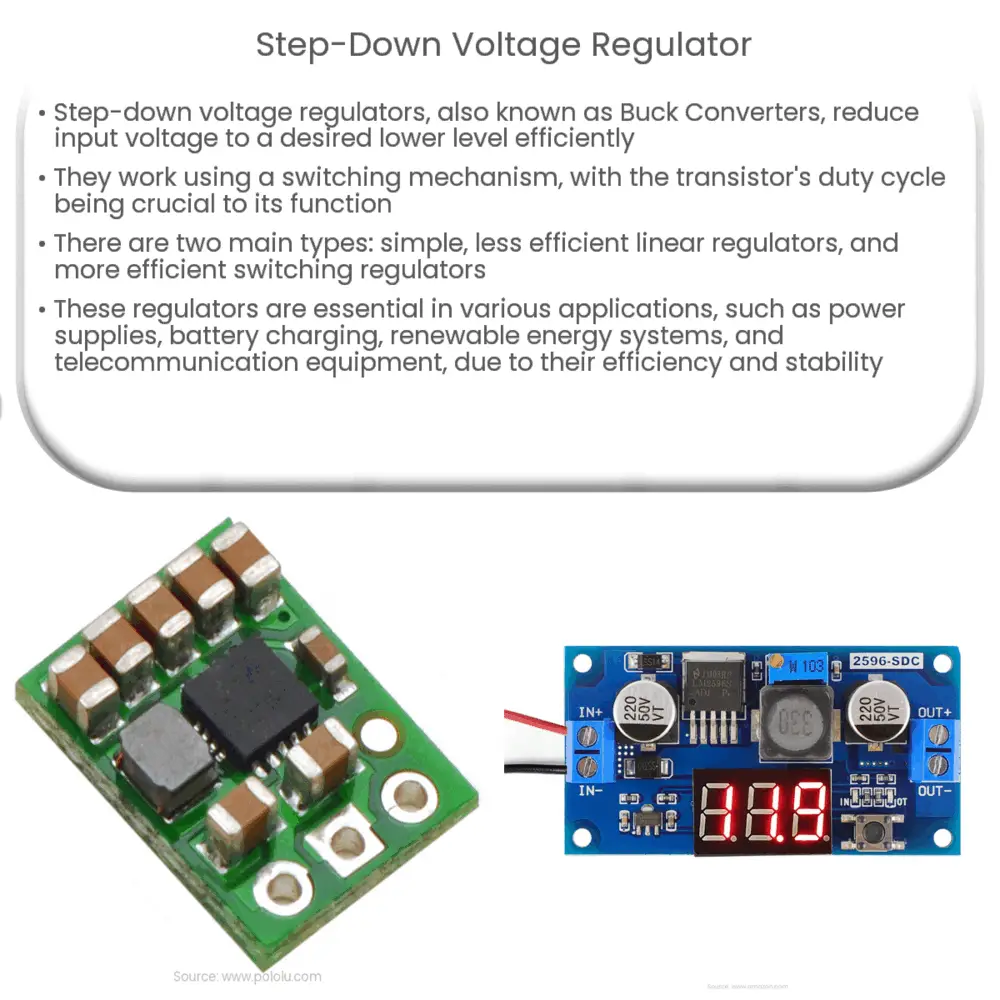Explore the role, functioning, types, applications, and advantages of Step-Down Voltage Regulators in modern electronics.

Introduction to Step-Down Voltage Regulators
A Step-Down Voltage Regulator, also known as a Buck Converter, is an essential component in modern electrical and electronic systems. Its primary function is to take an input voltage and reduce it to a desired lower output voltage, hence the term “step-down”. This process is accomplished while maintaining a high level of efficiency and minimizing energy loss.
Working Principle of Step-Down Voltage Regulators
The working principle of a step-down voltage regulator is based on the principles of switching power supply systems. It is a type of DC-to-DC converter that utilizes a transistor and a diode, which alternatively switch on and off, to control the flow of energy from input to output.
The key to the functioning of these regulators is the duty cycle of the switching transistor. The duty cycle, denoted as ‘D’, is the fraction of the total period for which the transistor is switched on. When the transistor is on, energy is stored in an inductor. When the transistor is off, this stored energy is released to the load, effectively reducing the voltage.
Key Components of Step-Down Voltage Regulators
- Switching Transistor: This is the main active component that switches on and off to control the energy flow.
- Diode: This component provides a path for the current when the transistor is off.
- Inductor: The inductor stores energy when the transistor is on and releases it when the transistor is off.
- Capacitor: This component smoothens out the voltage ripple produced by the switching operation.
Types of Step-Down Voltage Regulators
There are two main types of step-down voltage regulators:
- Linear regulators: These are simple devices that use a variable element to dissipate power and reduce voltage. They are easy to use but not very efficient as they tend to generate a lot of heat.
- Switching regulators: These are more complex but provide a far more efficient method of stepping down voltage. They work by rapidly switching the input voltage on and off, generating a lower average voltage.
Understanding the basic principles and types of step-down voltage regulators is essential for anyone working in electronics or electrical engineering. In the next section, we will delve deeper into the applications and benefits of these essential devices.
Applications of Step-Down Voltage Regulators
Step-down voltage regulators are used in a wide range of applications due to their ability to convert a high voltage to a lower voltage efficiently. Here are some of the common applications:
- Power Supplies: They are used in switch mode power supplies (SMPS) for devices like computers, televisions, and other electronics that require stable and efficient power.
- Battery Charging: They play a crucial role in battery management systems where they control the charging voltage supplied to batteries, particularly in electric vehicles.
- Renewable Energy Systems: In solar power systems, step-down voltage regulators are used to manage the voltage output from solar panels.
- Telecommunication Equipment: They are also used in telecommunication systems to manage power supply to the system’s electronic components.
Advantages of Step-Down Voltage Regulators
Step-down voltage regulators offer several advantages that make them a preferred choice for voltage regulation:
- High Efficiency: Switching regulators, in particular, are highly efficient as they control voltage by switching the input on and off, reducing power loss.
- Compact Size: They are typically smaller and lighter than other types of voltage regulators, which makes them ideal for portable devices.
- Versatility: They can be used in a wide range of applications, from power supplies to renewable energy systems.
- Stable Output: Despite variations in input voltage, they provide a steady output voltage, ensuring the proper functioning of electronic devices.
Conclusion
In conclusion, a step-down voltage regulator, whether it’s a simple linear regulator or a more complex switching regulator, plays a crucial role in various electronic and electrical systems. These devices ensure that the voltage supplied to electronic components is within their operating range, thereby preventing potential damage and ensuring efficient operation. As technology continues to evolve and the demand for efficient power management increases, the importance of understanding and utilizing step-down voltage regulators cannot be overstated.

